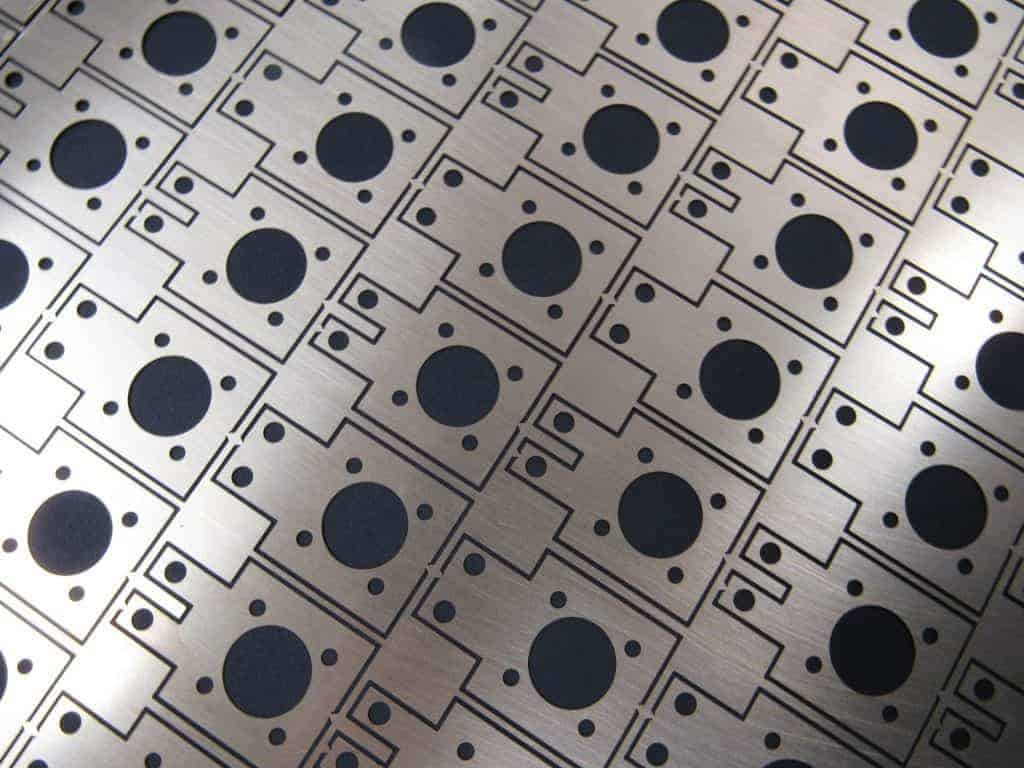Metal etching is one of the metal-cutting techniques that offer significant advantages over its counterparts because of the chemical metal etcher. The metal etcher is a strong acid that chemically reacts with the metal and dissolves it. Leaving behind an intricate design or marking in its wake.

Low-cost production, good repeatability, and high precision are only three of the many benefits that manufacturers from different industrial fields yield with metal etcher from the chemical etching process.
Including the most common benefits of chemical etching mentioned above, this article will discuss in detail some of the most significant advantages that a metal etcher has to offer in a chemical etching process.
But first,
A metal etcher is a chemical used in the chemical etching process. This chemical is a low-pH acidic solution that dissolves the metal surface and creates the required design.
A chemical etching process is a subtractive process that uses strong acid or a metal etcher. This metal etcher chemically reacts with the exposed surfaces of the metal. It dissolves them to create incisions on the metal surface that appear as designs.
The most common compound used as a metal etcher is Ferric Chloride. Ferric Chloride, when mixed with water, forms an acid.
Other acidic solutions that act as etchants in a chemical etching process include Hydrochloric acid, Sulfuric Acid, and Nitric Acid.
The etching is a highly-precise metal-cutting process. Moreover, with a quick turn-around time, it is more affordable as well. Hence, most manufacturers of tight-tolerance products such as mesh and grids, electronic components, and aesthetic pieces prefer chemical etching over other similar processes.
Precision and cost-efficacy are some of those advantages of a chemical etching process that are more popular among manufacturers.
However, we have dug a little deeper to reap some other benefits that make the metal etcher even more significant in the chemical etching process.
Metal etcher allows the chemical etching process to be extremely flexible. With a metal etcher, the etching process accommodates a wide range of materials with varying thickness, grades, and sheet sizes.
Chemical etching can etch metals as thin as less than 1.5 mm. Moreover, metal etcher can be used on sheets with size up to 600x1500 mm.
The metal etching process does not distinguish between types of metals used. Be it ferrous or non-ferrous metals, hard-to-machine metals like aluminum and titanium, or the high-melting alloys of Chromium and Nickel. It maintains its performance and guarantees results.
A complex design can become a nightmare for manufacture and design engineers. However, the metal etching process takes the nightmarish aspects of milling away from the manufacturing process of a complex design. And makes it simple and straightforward while maintaining high-precision and accuracy.
Interestingly enough, Chemical etching, unlike its counterparts, does not require any special tooling for complex designing. metal etcher does not cost more for a complex etching process than it would cost for a simple process. Unlike other milling processes, like stamping, where the expenses on tooling go up with the level of complexity.
Furthermore, in other processes for metal cutting, such as CNC machining and stamping, the fine-finishing diminishes, and the part features a low-quality finish if the design is too intricate and the milling process is not followed by a thorough finishing process.
However, fine-finishing is never a problem with a metal etcher. A metal etcher in a chemical etching process ensures a top-notch finish and fine-quality no matter how intricate and complex the design gets.
A metal etcher does not alter the properties of the material it acts on and this is one significant feature that gives it a clear edge over all other metal cutting techniques.
Metal etcher only reacts with the metal chemically, it does not heat it or strike it like in laser etching or stamping. So, chemical etching does not induce and mechanical or thermal stresses within the metal thereby ensuring their integrity.
Heat treating metals alter metal properties significantly because heating leads to allotropic phase transformation in allotropic metals. The consequent rearrangement of atoms in the metallic lattice alters the metal properties such as ductility, hardness, and strength.
Moreover, heat also reduces the metal's electrical conductivity and may minimize or diminish the magnetism of ferromagnetic materials.
Apart from heating, hammering, and applying deformation forces on the metals also lead to the development of internal stresses which result in may shear failure and ablative deformation.
Since chemical etching does not alter the properties of the material post-process. Therefore, it offers engineers ease during the material selection process. As, with a metal etcher, they do not have to estimate the possible changes in material properties after the process and then take them into account during material selection.
Burr is the extra material that develops on the edges of the metal after it has undergone a metal cutting or forming process. It appears as rough, raised edge, and reduces the materials finish quality, minimizes its precision and smoothness.
Heat and stress-inducing processes such as laser etching, drilling, and machining are among the biggest contributors to burr-formation in metals.
Burr on metals is not only unsightly, but it also renders products useless for applications that require a smooth surface with proper finish and tight tolerance. Therefore, de-burring, a costly process of burr-removal, becomes critical.
However, chemical etching uses an acidic metal etcher. This metal etcher only dissolves the undesired metal and leaves behind a smooth and precise metal. The chemical etching does not need to be followed by a de-burring process. Therefore, etching with a metal etcher is not only quick but cost-effective and promising in terms of precision and quality.
The chemical etching does not involve any tampered or sharp tool for incising the metal. Therefore, the precision of the design is not subjective to the precision of the tool and can be as precise as the design allows and the designer wills. And abiding by tight-tolerance specification is not an issue.
The chemical etching process is known among the manufacturers for its high accuracy. Its popularity is well-earned as it promises accuracy within +/- 10% of the metal thickness.
Moreover, the tooling for etching does not wear with the number of products made with it. It produces products with constant specifications and maintains a commendable consistency in tolerance.
The high repeatability of chemical etching makes it highly-suitable for bulk production with low cost and quick turnaround time.
Prototyping is imperative to ensure that the product performs optimally and meets all the requirements.
The conventional machining process would first require tooling for prototyping, which will need time and investment. And if in case, the prototype fails to meet the set specifications, the re-prototyping process will incur additional cost and delay the product delivery.
Prototyping using a metal etcher, on the other hand, is straightforward and does not need much investment. Therefore, All you need is a CAD file and the design printed on the Mylar film or some other similar polymer. Having these two things would suffice for prototype creation.
And in the event of the prototype not meeting the customer requirement, modification of the design is easy as the only thing that you’ll need to do would be to re-adjust the design, re-print it and make the prototype again.
Hence, metal etcher allows for rapid prototyping and saves valuable time by minimizing the lead time of a chemical etching process. And time in manufacturing is worth more than money.

Metal etcher ensures the precision, accuracy, and flexibility of the chemical etching process. Its most significant advantage is that it does not change the mechanical properties of the material, which not only maintains materials’ integrity but also makes it easier for the engineers to select the right material.
Because the metal etcher enhances the repeatability and turnaround the time of the chemical etching, therefore it renders the metal etching process more cost-effective than its counterparts.
In order to learn more, Contact Us Today
